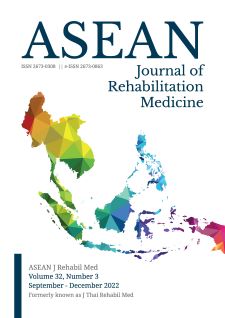Comparison of Walking and Balance Control between Gait and Balance Training on Perturbation Treadmill and Overground in Individuals with Chronic Stroke
Keywords:
stroke, walking, postural balance, perturbation treadmill, gait trainingAbstract
Objectives: To study changes in walking and balance control after receiving two different gait and balance training programs in stroke patients.
Study design: Asssessor-blinded randomized controlled trial.
Setting: Sirindhorn National Medical Rehabilitation Institute, Thailand.
Subjects: Outpatients with chronic stroke with ability to walk without ambulatory aids for at least 10 meters.
Methods: Eligible participants were randomized to experimental group of training on perturbation treadmill and control group of training on overground. Each participant received the assigned training which lasted 30 minutes per session, 3 days per week, for 4 weeks. Before the trainings, both groups received a bench exercise program for 30 minutes. Primary outcome was Timed Up and Go (TUG) test and secondary outcomes was Berg Balance Scale. The outcomes were assessed before and after completion of 12 training sessions.
Results: Only 9 participants in each group completed the study. Both groups had a decrease in TUG time and an increased in BBS score but only the latter reached statistical significant level (p < 0.05). There were no significant changes in pre-post differerence of TUG (experiment 1.10 vs control 1.18, p = 0.96) and BBS score (experiment 1.44.vs control 2.89, p = 0.17) between the two groups.
Conclusions: Due to small sample size, it is inconclusive that 12 sessions of 30-minute gait and balance training on perturba-tion treadmill improved walking and balance control same as overground training did in individuals with chronic stroke. A further study with adequate sample size should be done.
References
Suwanwela N. Stroke epidemiology in Thailand. JOS. 2014;16:1-7.
Bundhamcharoen K, Odton P, Phulkerd S, Tangcharoensathien V. Burden of disease in Thailand: changes in health gap between 1999 and 2004. BMC Public Health. 2011;11:53. doi:10.1186/1471-2458-11-53.
HDC service.moph.go.th [Internet]. Nonthaburi: The prevalence of stroke. [cited 2021 Dec 30]. Available from: https://hdcservice.moph.go.th/hdc/reports/report.php?source=formated/ncd.php&cat_id=6a1fdf282fd28180eed7d1cfe0155e11&id=3092c3c3250ae67155f7e134680c4152.
Zheng JQ, Lai HJ, Zheng CM, Yen YC, Lu KC, Hu CJ, et al. Association of stroke subtypes with risk of hip fracture: a population-based study in Taiwan. Arch Osteoporos. 2017;12:104. doi:org/10.1007/s11657-017-0390-8.
Tsang CSL, Pang MYC. Association of subsequent falls with evidence of dual-task interference while walking in community-dwelling individuals after stroke. Clin Rehabil. 2020;34:971-80.
Mehrholz J, Thomas S, Elsner B. Treadmill training and body weight support for walking after stroke. Cochrane Database Syst Rev. 2017;8:Cd002840.
Graham SA, Roth EJ, Brown DA. Walking and balance outcomes for stroke survivors: a randomized clinical trial comparing body-weight-supported treadmill training with versus without challenging mobility skills. J Neuroeng Rehabil. 2018;15:92. doi:org/10.1186/s12984-018-0442-3.
Pohl M, Mehrholz J, Ritschel C, Rückriem S. Speed-dependent treadmill training in ambulatory hemiparetic stroke patients: a randomized controlled trial. Stroke. 2002;33:553-8.
Ha SY, Sung YH. Effects of Fresnel prism glasses on balance and gait in stroke patients with hemiplegia: a randomized controlled trial pilot study. Technol Health Care. 2020;28:625-33.
Dusane S, Bhatt T. Effect of multisession progressive gait-slip training on fall-resisting skills of people with chronic stroke: examining motor adaptation in reactive stability. Brain Sci. 2021;11,894. doi:org/10.3390/brainsci11070894.
Nørgaard JE, Andersen S, Ryg J, Stevenson AJT, Andreasen J, Danielsen MB, et al. Effects of treadmill slip and trip perturbation-based balance training on falls in community-dwelling older adults (STABILITY): study protocol for a randomised controlled trial. BMJ Open. 2022;12:e052492. doi: 10.1136/bmjopen-2021-.
Protas EJ, Mitchell K, Williams A, Qureshy H, Caroline K, Lai EC. Gait and step training to reduce falls in Parkinson’s disease. Neuro Rehabilitation. 2005;20:183-90.
O’Sullivan SB, Schmitz TJ, Fulk GD. Physical rehabilitation: 6th ed. Philadelphia: FA Davis. 2014.
Shumway-Cook A, Brauer S, Woollacott M. Predicting the probability for falls in community-dwelling older adults using the timed up & go test. Phys Ther. 2000;80:896-903.
Andrenacci I, Boccaccini R, Bolzoni A, Colavolpe G, Costantino C, Federico M, et al. A comparative evaluation of Inertial Sensors for gait and jump analysis. Sensors. 2021;21,5990. doi:org/10.3390/s21185990.
Berg KO, Wood-Dauphinee SL, Williams JI, Maki B. Measuring balance in the elderly: validation of an instrument. Can J Public Health. 1992;83 Suppl 2:S7-11.
Jung J, Yu J, Kang H. Effects of virtual reality treadmill training on balance and balance self-efficacy in stroke patients with a history of falling. J Phys Ther Sci. 2012;24:1133-6.
Van Duijnhoven HJ, Heeren A, Peters MA, Veerbeek JM, Kwakkel G, Geurts AC, et al. Effects of exercise therapy on balance capacity in chronic stroke: systematic review and meta-analysis. Stroke. 2016;47:2603-10.
Liaw LJ, Hsieh CL, Lo SK, Chen HM, Lee S, Lin JH. The relative and absolute reliability of two balance performance measures in chronic stroke patients. Disabil Rehabil. 2008;30:656-61.
Tamura S, Miyata K, Kobayashi S, Takeda R, Iwamoto H. The minimal clinically important difference in Berg Balance Scale scores among patients with early subacute stroke: a multicenter, retrospective, observational study. Top Stroke Rehabil. 2022;29:423-9.
Downloads
Published
How to Cite
Issue
Section
License

This work is licensed under a Creative Commons Attribution-NonCommercial-NoDerivatives 4.0 International License.






